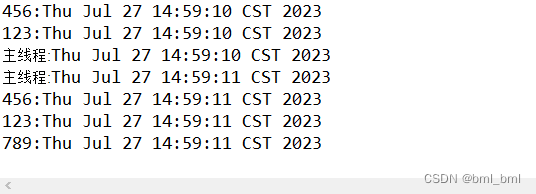1.Thread 继承与实现
实现了
class Thread implements Runnable
Runnable
Runnable 就一个抽象接口run()
@FunctionalInterface
public interface Runnable {
public abstract void run();
}
2.多线程创建
1.继承Thread类
自定义一个类MyThread类,用来继承与Thread类,在MyThread类中重写run()方法,在测试类中创建MyThread类的对象,启动线程
public class test1 {
public static void main(String[] args) {
MyThread t0 = new MyThread("123");
MyThread t1 = new MyThread("456");
MyThread t2 = new MyThread("789");
//t0.run();
//t1.run();
//t2.run();
// 不会启动线程,不会分配新的分支栈。(这种方式就是单线程。)
// start()方法的作用是:启动一个分支线程,在JVM中开辟一个新的栈空间,这段代码任务完成之后,瞬间就结束了。
// 这段代码的任务只是为了开启一个新的栈空间,只要新的栈空间开出来,start()方法就结束了。线程就启动成功了。
// 启动成功的线程会自动调用run方法,并且run方法在分支栈的栈底部(压栈)。
// run方法在分支栈的栈底部,main方法在主栈的栈底部。run和main是平级的。
t0.start();
t1.start();
t2.start();
Thread.currentThread().setName("主线程");
while(true) {
try {
Thread.sleep(1000);
} catch (InterruptedException e) {
e.printStackTrace();
}
System.out.println(Thread.currentThread().getName()+":"+new Date());
}
}
}
public class MyThread extends Thread{
public MyThread() {
}
public MyThread(String name) {
super(name);
}
@Override
public void run() {
while(true) {
try {
Thread.sleep(1000);
} catch (InterruptedException e) {
e.printStackTrace();
}
System.out.println(this.getName()+":"+new Date());
}
}
}
输出结果

2.实现Runnable接口
自定义一个MyRunnable类来实现Runnable接口,在MyRunnable类中重写run()方法,创建Thread对象,并把MyRunnable对象作为Tread类构造方法的参数传递进去,然后启动线程
public class ThreadTest2 {
public static void main(String[] args) {
MyRunnable myRun = new MyRunnable();
Thread t0 = new Thread(myRun,"123");
Thread t1 = new Thread(myRun,"456");
Thread t2 = new Thread(myRun,"789");
t0.start();
t1.start();
t2.start();
Thread.currentThread().setName("主线程");
while(true) {
try {
Thread.sleep(1000);
} catch (InterruptedException e) {
e.printStackTrace();
}
System.out.println(Thread.currentThread().getName()+":"+new Date());
}
}
}
public class MyRunnable implements Runnable{
@Override
public void run() {
while(true) {
try {
Thread.sleep(1000);
} catch (InterruptedException e) {
e.printStackTrace();
}
System.out.println(Thread.currentThread().getName()+":"+new Date());
}
}
}
3.实现Callable接口
( java.util.concurrent.FutureTask; /JUC包下的,属于java的并发包,老JDK中没有这个包。新特性。)
自定义一个MyCallable类来实现Callable接口,在MyCallable类中重写call()方法,创建FutureTask,Thread对象,并把MyCallable对象作为FutureTask类构造方法的参数传递进去,把FutureTask对象传递给Thread对象。启动线程
- 这种方式的优点:可以获取到线程的执行结果。
- 这种方式的缺点:效率比较低,在获取t线程执行结果的时候,当前线程受阻塞,效率较低。
public class ThreadTest3 {
public static void main(String[] args) {
FutureTask<InnerClass> task = new FutureTask<InnerClass>(new Callable<InnerClass>() {
InnerClass innerClass = new InnerClass(0,0);
@Override
public InnerClass call() throws Exception {
for (int i = 0; i < 20; i++) {
Thread.sleep(1000);
innerClass.a++;
System.err.println(innerClass.a);
innerClass.b+=innerClass.a;
}
return innerClass;
}
});
Thread t = new Thread(task);
t.start();
InnerClass inc;
try {
inc = task.get();
System.err.println(inc.toString());
} catch (InterruptedException | ExecutionException e) {
e.printStackTrace();
}
Thread.currentThread().setName("主线程");
while(true) {
try {
Thread.sleep(1000);
} catch (InterruptedException e) {
e.printStackTrace();
}
System.out.println(Thread.currentThread().getName()+":"+new Date());
}
}
}
public class InnerClass{
int a = 0;
int b = 0;
public InnerClass() {
super();
}
public InnerClass(int a, int b) {
super();
this.a = a;
this.b = b;
}
@Override
public String toString() {
return "InnerClass [a=" + a + ", b=" + b + "]";
}
}
进入线程阻塞,执行完后才执行主线程























 220
220











 被折叠的 条评论
为什么被折叠?
被折叠的 条评论
为什么被折叠?








